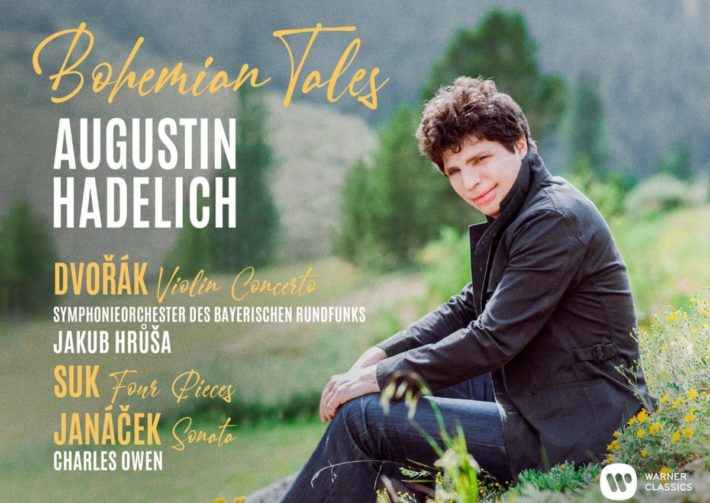From concertos of Mendelssohn and Sibelius to Bartók and Ligeti, violinist Augustin Hadelich has built a remarkable discography. Adding to this resumé is this creatively programmed release, entitled “Bohemian Tales”. Hadelich is joined by conductor Jakub Hrůša and the Symphonie-Orchester des Bayerischen Rundfunks in the Dvořák’s Violin Concerto; and by pianist Charles Owen in the chamber pieces by Dvořák, Suk, and Janáček.
Hadelich turns Dvořák’s conventionally structured concerto into more of a tone poem; understanding the passionate, turbulent emotions in an almost Gypsyesque fashion. The “allegro ma non troppo” tempo is not adhered to as closely as Julie Fischer, but it still captures the essence of the Czech spirit synonymous with the recording made by Joseph Suk, the composer’s great-grandson.
From the first notes, there is a vivacity, drama, a command which is direct, immediate, and authoritative. The open violin flourish styled as a quasi-recitative, making the boldest of statements. There is indeed a rhapsodic nature to Hadelich’s approach, and he does take on a role of a storyteller, using the violin to communicate a memorable tale, as if pulling surprises from under his cloak.
In the slow movement, Hadelich takes risks emotionally, but his communicative power to take the listener with him is decisively persuasive. Throughout the final movement, Hadelich establishes a lovely conversation between the violin and the orchestra, setting them up as equals in this romping, dance-like “allegro giocoso non troppo”. Hadelich and Hrůša bring all the color of Dvořák’s Slavonic Dances to this highly virtuosic, rhythmically taut and uplifting finale.
The playing from the Symphonie-Orchester des Bayerischen Rundfunks is superb, a testament to Hrüsa’s conducting. The woodwinds have beauty and the brass a richness. The flute solos are particularly fine, complementing Hadelich’s beautiful tone.
Related Classical Music Reviews
- Review: Dvořák – Requiem, Te Deum, Biblical Songs – Hrůša, Bělohlávek
- Review: Janáček and Ligeti String Quartets – Belcea Quartet
- Review: Grieg – Violin Sonatas – Hemsing, Trpčeski
Janàček’s violin sonata contrasts starkly with the more conventional works around it. Hadelich maintains a narrative throughout the work, echoing the “Overgrown Path” piano cycle, and the range of colors he evokes in the opening movement is impressively kaleidoscopic. This high level of expression continues into the second movement, in which he evokes a Mendelssohnian Song Without Words, bringing a radiant cantabile tone to the violin line and phrasing which is vocally inspired. The final movement encapsulates a whole range of fixed and heavy emotions, in which both Hadelich and Owen are highly communicative and sincere.
Suk’s virtuosic Four Pieces (op. 17) which follows flow effortlessly from Hadelich’s bow. The second “Appassionata” movement particularly impressive, not only for its precision but also for its emotional directness and conviction.
In the chamber works, Hadelich’s tone is remarkably varied across the entire range of the instrument. The lower strings have a richness whilst the upper strings have a song-like quality. Vibrato is measured and paced, used with sophistication, and never strays into the area of over-sentimentality. His intonation is precise and flawless. Hadelich provides his own booklet notes in a personal but informative way, complementing a highly enjoyable release.

Dvořák – Violin Concerto, Op. 53
Janáček – Violin Sonata
Suk – 4 Pieces, Op. 17
Augustin Hadelich – Violin
Symphonieorchester Des Bayerischen Rundfunks
Jakub Hrůša – Conductor
Warner Classics, CD 9029527476
Recommended Comparisons
Read more classical music reviews or visit The Classic Review Amazon store
Follow Us and Comment:
Get our periodic classical music newsletter with our recent reviews, news and beginners guides.
We respect your privacy.









